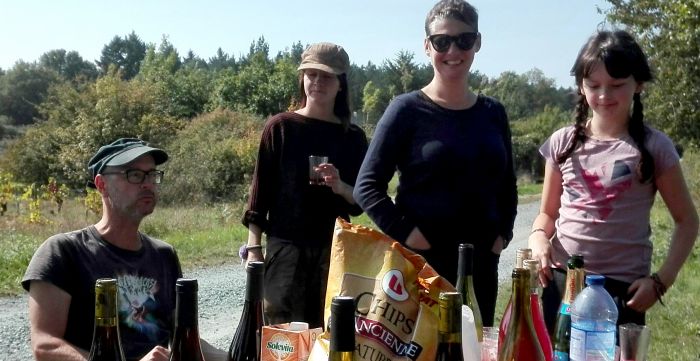
producer profile
11.07.2019
Philippe Chevarin Producer Profile
<p>In a past life, Philippe Chevarin was an audio engineer. Starting as a musician, he eventually shifted his interests to the technical aspects of sound. Completely self taught, after reading a few books he started gigging with local bands as well as mixing and mastering recordings. This 23 year career would see him working with unknown noise-bands to more famous acts like Vanessa Paradis.</p>
<p>Originally from the Southwest, Philippe moved to <glossary title="707">Nantes</glossary> after meeting his future wife. There he met her childhood friend Cécile Argondico, who just so happens to be married to <a href="http://louisdressner.com/producers/clos%20du%20tue-boeuf">Thierry Puzelat</a>. Meeting Thierry fueled Philippe's blossoming love affair with wine and coincided with an increasing disillusionment with the business side of the music industry.<br />
<br />
Engineering gave Philippe a lot of downtime, so he began studying <glossary title="1103">viticulture</glossary> and <span class="zalup"><span><glossary title="422">oenology</glossary><span>.</span></span></span> This eventually landed him at a two year apprenticeship with Jacques and Agnes Carroget at <a href="http://zrswines.com/wine-producer/domaine-de-la-paonnerie/">Domaine de la Paonnerie</a>. From this experience Philippe was confident he wanted become a <span class="zalup"><span><glossary title="1089">vigneron </glossary></span></span>and asked Jacques to help him find vines. <br />
<br />
Starting with two <glossary title="523">hectares</glossary> in 2014 (the grapes from this <glossary title="1109">vintage</glossary> were sold to <a href="http://louisdressner.com/producers/pierre-olivier%20bonhomme">Pierre-O Bonhomme</a> and <a href="http://louisdressner.com/producers/agn%C3%A8s%20et%20ren%C3%A9%20mosse">René Mosse</a>), Philippe now finds himself with about five <glossary title="523">hectares</glossary> of vines. Two thirds of the production consists of <span class="zalup"><span><glossary title="646">Melon de Bourgogne</glossary><span>,</span></span></span> with <span class="zalup"><span><glossary title="478">Gamay</glossary><span>,</span></span></span> <glossary title="513">Grolleau</glossary> and a bit or <glossary title="217">Cabernet Sauvignon</glossary> rounding out the lineup. The wines are <glossary title="185">bottled</glossary> as <span class="zalup"><span><glossary title="1092">Vin de France</glossary><span>,</span></span></span> but would fall under <glossary term="Muscadet Coteaux de la Loire" title="1338">Muscadet-Coteaux-de-la-Loire</glossary> for the whites and <glossary title="346">Coteaux d'Ancenis</glossary> for the reds if under the <glossary title="113">appellation</glossary> system. </p>
<p><span class="zalup"><span><span>The vines are worked <glossary term="Organic" title="746">organically</glossary> and in <glossary term="Ecocert" title="413">Ecocert</glossary> <span class="zalup"><span><glossary term="Conversion" title="332">conversion</glossary><span>.</span></span></span> The previous owner had left them in pretty terrible shape: shockingly many of the <glossary term="Parcel" title="760">parcels</glossary> are only planted at 50% capacity from neglect. With a few <glossary term="Vintage" title="1109">vintages</glossary> now under his belt, Philippe is increasingly starting to realize that while some <glossary term="Plot" title="1133">plots</glossary> are worth restoring, others are simply too far gone and need to be abandoned for new land. This coupled with three out of his five first <glossary term="Vintage" title="1109">vintages</glossary> suffering from catastrophic <glossary term="Frost" title="1135">frost</glossary>/<glossary term="Hail" title="1136">hail</glossary>/<glossary term="Mildew" title="1137">mildew</glossary> damage has forced Philippe to obtain a <glossary term="Négociant" title="729">négociant</glossary> license as of the 2021 <span class="zalup"><span><glossary term="Vintage" title="1109">vintage</glossary><span>.</span></span></span> </span></span></span></p>
<p><span class="zalup"><span><span>The <glossary term="Cellar" title="254">cellar</glossary> is one of the smallest we've ever seen. When asked on a recent visit if he would ever expand from this tiny <glossary term="Schist" title="933">schist</glossary> <glossary term="Cave" title="251">cave</glossary> filled only with <glossary term="Fiberglass" title="445">fiberglass</glossary> <span class="zalup"><span><glossary term="Vat/Tank" title="1140">tanks</glossary><span>,</span></span></span> Philippe answered with a pragmatic and philosophical analogy to these limitations:</span></span></span></p>
<p><em><span class="zalup"><span><span>"I see it as a way of staying focused and not getting caught up with bells and whistles. When I was mixing and mastering records, I always used the same basic board with no effects. It was a very minimal approach but I mastered that board and learned how to get the best from it."</span></span></span></em></p>
<p><span class="zalup"><span><span>It’s no frills and no distractions style of winemaking. Philippe is the first to admit he is still mastering the intricacies of <glossary term="Vinification" title="1104">vinification</glossary> but believes first and foremost that better <glossary term="Viticulture" title="1103">viticulture</glossary> will be the conduit to better wines.</span></span></span><span class="zalup"><span><span> </span></span></span>From his first <glossary term="Vintage" title="1109">vintage</glossary> in 2015, he's aimed to <glossary term="Vinification" title="1104">vinify</glossary> as simply as possible. All the wines <glossary term="Fermentation" title="441">ferment</glossary> and <glossary term="Aging" title="74">age</glossary> in <glossary term="Fiberglass" title="445">fiberglass</glossary> <glossary term="Vat/Tank" title="1140">tanks</glossary> and go through <span class="zalup"><span><glossary term="Malolactic Fermentation" title="622">malo</glossary><span>.</span></span></span> His goal is to not use <glossary term="Sulfites" title="993">S02</glossary> at any point, but in recent <glossary term="Vintage" title="1109">vintages</glossary> Philippe has added microscopic amounts to his whites. As of the 2020 <span class="zalup"><span><glossary term="Vintage" title="1109">vintage</glossary><span>,</span></span></span> wines with no added <glossary term="Sulfites" title="993">S02</glossary> are indicated with a "no <glossary term="Sulfites" title="993">sulfites</glossary> added" mention on the <span class="zalup"><span><glossary term="Wine Label" title="573">front label</glossary><span>.</span></span></span> </p>
Article
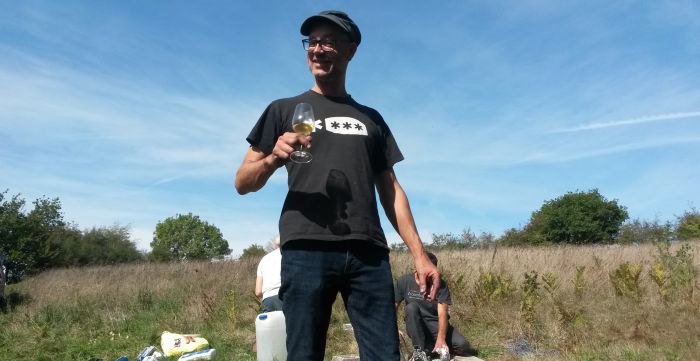
interview
11.07.2019
An interview with Philippe Chevarin from 2017
<p><em>This interview with Philippe Chevarin took place over Skype in April, 2017.</em></p>
<p><strong>You aren't from an agricultural background right? </strong><br />
<br />
Not at all. I used to be an audio engineer. I would go on tour with bands and singers doing live sound. <br />
<br />
<strong>No studio work?</strong><br />
<br />
I worked in studios a bit but ended up being really focused on live music. <br />
<br />
<strong>What kind of music?</strong><br />
<br />
It went from noisy, dirty rock n' roll to larger acts like Vanessa Paradis. <br />
<br />
<strong>How did you end up an audio engineer?</strong><br />
<br />
I started as a musician. When I realized I wasn't good enough to ever make a living at it, I shifted my focus to the technical side of sound. I read some books and learned everything on my own.<br />
<br />
<strong>How long did this first career last?</strong><br />
<br />
From 1991 to 2015. <br />
<br />
<strong>So what made you change paths and start making wine?</strong><br />
<br />
I'd done the rounds with my job. Growing meant doing bigger productions... I was really turned off by the business side of bigger show and knew it wasn't for me in the long term.<br />
<br />
So I decided it was time for a change. One idea was to open a wine bar with my wife, because I was already completely in love with it. But is just so happens she is childhood friends with Thierry Puzelat's wife Cécile. Through Thierry I was introduced to Pierre-O Bonhomme, René Mosse... It was inspiring. <br />
<br />
Because I had a lot of downtime with work, I decided to study <glossary title="1103">viticulture</glossary> and <glossary title="422">oenology</glossary> on the side. This placed me in a two year stage at Domaine de la Paonnerie, about 30 minutes from <span class="zalup"><span><glossary title="707">Nantes</glossary><span>.</span></span></span> After two years with Jacques and Agnès, I knew I wanted to be a <span class="zalup"><span><glossary title="1089">vigneron</glossary><span>.</span></span></span> And since I'd gotten used to that area, I asked them to help me find vines close by.<br />
<br />
<strong>Did you move from Nantes?</strong><br />
<br />
No, we still live in <span class="zalup"><span><glossary title="707">Nantes</glossary><span>.</span></span></span> It's about a 35 minute drive. <br />
<br />
<strong>Tell me about the vines you were able to acquire. </strong><br />
<br />
It was a bit of a particular situation. The vines had been abandoned for three years. The <glossary title="1089">vigneron</glossary> next to them <glossary title="328">treated</glossary> them once a year to make sure they wouldn't get sick and affect his own vines, but other than that not much was happening. <br />
<br />
Basically the guy was taking care of them disappeared overnight. He didn't pay for his rentals, there was a trial... Anyhow, when I took them over they were a little bit damaged. But by hanging out in the village, I started meeting farmers and some offered me more land. <br />
<br />
<strong>So how much land did you start with, and where are you at today? </strong><br />
<br />
I started with 2.8 <glossary title="523">hectares</glossary> of <span class="zalup"><span><glossary title="646">Melon de Bourgogne</glossary><span>,</span></span></span> <glossary title="478">Gamay</glossary> and<strong> <glossary title="217">Cabernet Sauvignon</glossary></strong>. I took those over in March, 2014. That year I sold my grapes to Pierre-O Bonhomme and René Mosse. 2015 was my first <glossary title="1109">vintage</glossary> working the vines full time and making my own wine. <br />
<br />
<strong>So how much land are you working now, and what is the breakdown grape wise?</strong><br />
<br />
I'm at 5.3 <glossary title="523">hectares</glossary> now. I'm buying 40 <glossary title="1208">ares</glossary> of vines this year, and the rest is in <glossary title="440">fermage</glossary>; I give them some wine and they let me work their land. Essentially it's people who care about keeping their vines alive but can't work them themselves. They don't want the vines ripped out. <br />
<br />
As far as my surface, I'm at around 2/3 in <span class="zalup"><span><glossary title="646">Melon</glossary><span>,</span></span></span> 1/3 of <glossary title="478">Gamay</glossary> and a tiny bit of<strong> <glossary title="217">Cabernet Sauvignon</glossary></strong> and <span class="zalup"><span><glossary title="513">Grolleau</glossary><span>.</span></span></span> The soils consist principally of <span class="zalup"><span><glossary title="933">schist</glossary><span>,</span></span></span> <glossary title="842">quartz</glossary> and <span class="zalup"><span><glossary title="910">sandstone</glossary><span>.</span></span></span> These are really "vineyard soils". Nothing else can grow in them.<br />
<br />
<strong>How old are the vines?</strong><br />
<br />
I have two mains <span class="zalup"><span><glossary title="1133">plots</glossary><span>.</span></span></span> In the first, the oldest vines were planted in 1969, but most are from the 80's. For the the second <span class="zalup"><span><glossary title="1133">plot</glossary><span>,</span></span></span> I've got some <glossary title="478">Gamay</glossary> from the 50's. And I'm about to get some <glossary title="646">Melon de Bourgogne</glossary> planted in 1948.<br />
<br />
<strong>Can you break down the wines you make?</strong><br />
<br />
The <glossary title="646">Melon</glossary> is called "Le Souffle<em>"</em>. It's a <glossary title="168">blend</glossary> of all my <glossary title="760">parcels</glossary>; I don't have enough juice or space in my <glossary title="254">cellar</glossary> to do otherwise. I do a <span class="zalup"><span><glossary title="392">direct</glossary><span>,</span></span></span> <glossary title="964">slow-press</glossary> with the old <glossary title="935">screw-press</glossary> I own, it takes about four hours. <glossary title="622">Malo</glossary> happens and so far I have succeeded in not adding any <span class="zalup"><span><glossary title="993">sulfur</glossary><span>.</span></span></span> It worked my first two <glossary title="1109">vintages</glossary> so we'll see.<br />
<br />
Then I have a <glossary title="478">Gamay</glossary> <glossary title="871">rosé</glossary> called "La Goulée<em>"</em> but I'm going to change the name because Benoit Courault also makes a wine with that name. But that's what it's called for now. It's also <span class="zalup"><span><glossary title="392">direct-press</glossary><span>,</span></span></span> and ends up as a fairly colored <span class="zalup"><span><glossary title="871">rosé</glossary><span>.</span></span></span> <br />
<br />
My <glossary title="478">Gamay</glossary> is called "Les Sentinelles", which is a more ample style, with nice <glossary title="990">structure</glossary> and <span class="zalup"><span><glossary title="1010">tannin</glossary><span>.</span></span></span> In 2015 I made it <span class="zalup"><span><glossary title="1124">whole-cluster</glossary><span>,</span></span></span> so it has a <glossary title="942">semi-carbonic</glossary> profile. In 2016, I made it half <span class="zalup"><span><glossary title="1124">whole-cluster</glossary><span>,</span></span></span> half <span class="zalup"><span><glossary title="378">destemmed</glossary><span>.</span></span></span> <br />
<br />
Then there is a <glossary title="513">Grolleau</glossary> called "L'Oublie", which is in tiny quantities. <br />
<br />
Then there is a <glossary title="217">Cabernet Sauvignon</glossary> <strong><glossary title="778">pétillant naturel</glossary></strong> called "Coup d'Pouce<em>"</em> that I <glossary title="521">harvest</glossary> with my friends and neighbors. <br />
<br />
Finally there is a <glossary title="478">Gamay</glossary> <strong><glossary title="778">pétillant naturel</glossary> </strong>called "La Houle", made half with <glossary title="478">Gamay</glossary> <glossary title="">Teinturier</glossary> (<glossary title="478">Gamay</glossary> with red pulp) and half <glossary title="478">Gamay</glossary> Noir à Jus Blanc. I decided to take out the <glossary title="1017">Teinturier</glossary> from "Les Sentinelles<em>"</em> because it gave the wine an animal quality I wasn't into. I'm really happy because having the red pulp gives the wine a great color. So I think I'll stick with this. <br />
<br />
I’ll admit that I’m really new at this and still experimenting with <span class="zalup"><span><glossary title="1104">vinification</glossary><span>.</span></span></span> I don’t how if the way I make wine today will always be the same. <br />
<br />
<strong>What’s the work in the vines like?</strong><br />
<br />
I’m <glossary title="332">converting</glossary> the vines to <span class="zalup"><span><glossary title="746">organics</glossary><span>,</span></span></span> and waiting to get <glossary title="260">certified</glossary> by <span class="zalup"><span><glossary title="413">Ecocert</glossary><span>.</span></span></span> Whenever I get some new land, it's immediately <span class="zalup"><span><glossary title="332">converted</glossary><span>.</span></span></span> <br />
<br />
I work the soils with a tractor. We only use <glossary title="333">copper</glossary> and <glossary title="993">sulfur</glossary> in the vineyards, and last year I experimented with some essential oils. This year I will try some <glossary title="160">biodynamic</glossary> preparations and see how it goes. <br />
<br />
<strong>Was it always in your plan to work "naturally"?</strong><br />
<br />
I can’t envision any other way. It’s a matter of personal taste: I was drawn to wine through <span class="zalup"><span><glossary title="708">natural wine</glossary><span>,</span></span></span> and that’s what I want to drink and what I want to make. <br />
<br />
But at the same time, if I feel I need to add <span class="zalup"><span><glossary title="993">sulfur</glossary><span>,</span></span></span> I’ll do it. There is an economic reality to what we do, and as a young <glossary title="1089">vigneron</glossary> who suffered a very rough second <glossary title="1109">vintage</glossary> (2016), I can’t permit myself to have an unsellable product.<br />
<br />
<strong>Your wines are all intentionally declassified as Vin de France. Can you elaborate on that?</strong><br />
<br />
If I were under the <glossary title="113">appellation</glossary> system, the whites would fall under <glossary title="1338">Muscadet des Coteaux de la Loire</glossary> and the reds would be <span class="zalup"><span><glossary title="346">Coteaux D’Ancenis</glossary><span>.</span></span></span> Entering an <glossary title="113">appellation</glossary> takes time and costs money. Plus I’m making an <glossary title="913">sans souffre</glossary> <glossary title="646">Melon de Bourgogne</glossary> that goes through <span class="zalup"><span><glossary title="622">malo</glossary><span>,</span></span></span> it’s not even worth trying to present them to the panel. <br />
<br />
My neighbor Jacques Février, who also works <span class="zalup"><span><glossary title="708">naturally</glossary><span>,</span></span></span> had approached the <glossary title="113">appellation</glossary> about being more open to trying wines like ours. A woman came to his house and started criticizing the wild grass in his <span class="zalup"><span><glossary title="760">parcels</glossary><span>!</span></span></span> If it’s to hear shit like that, it’s not worth it for me. <br />
<br />
However, we have mobilized with a group of like-minded growers and started an association called Pinards et Jus. We take our wines by boat from Oudon to <glossary title="707">Nantes</glossary> and organize a tasting there. The goal is to promote what we are doing in the region. All of us work <glossary title="746">organically</glossary> and “<glossary title="708">naturally</glossary>” in the <span class="zalup"><span><glossary title="254">cellar</glossary><span>,</span></span></span> and only one of us is in the <span class="zalup"><span><glossary title="113">appellation</glossary><span>.</span></span></span> He’s fought hard to be in the <span class="zalup"><span><glossary title="113">appellation</glossary><span>,</span></span></span> and is really trying to shape the tasting panel into understanding the characteristics of our wines, particularly ones without added <span class="zalup"><span><glossary title="993">sulfur</glossary><span>.</span></span></span> <br />
<br />
So there is SOME movement. And the truth is, if we want to see change it will depend on our actions. Nothing is going to change on its own.<br />
<br />
<strong>Are you from the Loire?</strong><br />
<br />
No, no, I'm from the Southwest. I came to <glossary title="707">Nantes</glossary> in 2002 after a 15 year stint in <span class="zalup"><span><glossary title="178">Bordeaux</glossary><span>.</span></span></span> I had been planning to move anyway, but I met someone from there and that was a good excuse as any. <br />
<br />
<strong>Anything you’d like to add?</strong><br />
<br />
I often say that my goal, at least for the time being, is to make simple wine. I’m still learning how to do this, but all I want is to do the best possible work in the vineyards, to give them as much life as possible to in turn pick beautiful grapes. I want to make a simple, approachable wine with the <glossary title="664">least amount of intervention</glossary> possible.</p>
Article
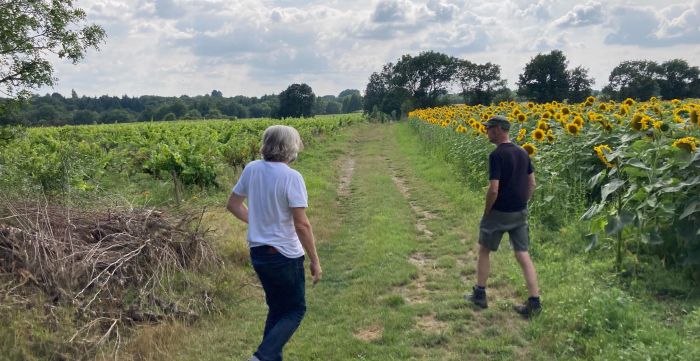
producer visit
04.10.2021
This visit with Philippe Chevarin took place in July, 2021.
<p><em><strong>Words and photos by Jules Dressner.</strong></em></p>
<p>This visit with Philippe Chevarin was five years in the making. You see, it's very rare that we start with a new <glossary term="Estate" title="427">estate</glossary> before visiting them. And even if that does happen, there is usually some history or past connection and a visit shortly follows. Yet with Philippe, we just couldn't seem to lock it in: he's not exactly far from Pépière or Luneau-Papin, yet all of our recents visits there were with our winter mega-groups. Considering three people can barely squeeze into Philippe's <span class="zalup"><span><glossary term="Cellar" title="254">cellar</glossary><span>.</span></span></span>..</p>
<p>Anyhow, though COVID delayed the daunting task of visiting all of our <glossary term="Loire Valley" title="602">Loire</glossary> producers in 2020 (it ended up being 28 visits in 14 days), we finally did it! After a few minutes freaking out some locals looking around for his address, Philippe's logo confirmed we were in the right place.</p>
<p><img src="https://louisdressner.com/uploads/images/article//885/91/9b/919bf796afb8f65466f6e83188fdeea0.jpg" /></p>
<p>Philippe's vines, <glossary term="Cellar" title="254">cellar</glossary> and storage are in Oudon, a tiny village about 35 minutes north-east of <glossary term="Nantes" title="707">Nantes</glossary> following the <span class="zalup"><span><glossary term="Loire River" title="603">Loire river</glossary><span>.</span></span></span> It's a part of the <glossary term="Loire Valley" title="602">Loire valley</glossary> I'd never visited so there was a distinct sense of excitement and discovery. </p>
<p>We started by checking out Philippe's TINY <span class="zalup"><span><glossary term="Cellar" title="254">cellar</glossary><span>.</span></span></span> </p>
<p><img src="https://louisdressner.com/uploads/images/article//885/b5/c4/b5c4224c4a23cf3cdb3ecdb427ab15e5.jpg" /><img src="https://louisdressner.com/uploads/images/article//885/e4/6e/e46efe865af36d918905715ffe366432.jpg" /></p>
<p><em>“It was just very hard to find anything when I took over. People used to only have a few </em><glossary term="Hectare" title="523"><em>hectares</em></glossary><em> and make very little wine so </em><glossary term="Cellar" title="254"><em>cellars</em></glossary><em> are rare. Most have converted them to garages or houses. At least this used to be a wine </em><glossary term="Cellar" title="254"><em>cellar</em></glossary><em> so there are good </em><glossary term="Yeast" title="1128"><em>yeasts</em></glossary><em> in it.”</em></p>
<p>The size makes any kind of intervention logistically complicated. For example, <glossary term="Racking/Soutirage" title="843">racking</glossary> one <glossary term="Vat/Tank" title="1140">tank</glossary> might mean moving another two out for the way.</p>
<p><em>"If I wanted to have a big, functional </em><glossary term="Cellar" title="254"><em>cellar</em></glossary><em> I'd have to build it myself. Right now I don't have the money to do this. And honestly I'm not sure I even want to." </em></p>
<p>Later that night at dinner, Philippe used a pragmatic and philosophical analogy to describe these limitations:</p>
<p><em>"I see it as a way of staying focused and not getting caught up with bells and whistles. When I was mixing and mastering records, I always used the same basic board with no effects. It was a very minimal approach but I mastered that board and learned how to get the best from it."</em></p>
<p>Nearby, Philippe also has a small storage room that can hold a very snug 20,000 bottles.</p>
<p><img src="https://louisdressner.com/uploads/images/article//885/40/4f/404f68dcc352bad7e3d1d04eb88877dc.jpg" /></p>
<p>The soils of the area are <glossary term="Schist" title="933">schist</glossary> and <span class="zalup"><span><glossary term="Quartz" title="842">quartz</glossary><span>,</span></span></span> which is what the old local houses are built in.</p>
<p><img src="https://louisdressner.com/uploads/images/article//885/96/48/964864ab5994bf4167df8be35ca2a16e.jpg" /></p>
<p>It was then time to see some vines. The first vineyard we visited is called Le Moulin D’Omblepied.</p>
<p><img src="https://louisdressner.com/uploads/images/article//885/e8/8b/e88b2ba2c2067abc95d9e5b169391ed0.jpg" /><img src="https://louisdressner.com/uploads/images/article//885/d5/b7/d5b7e9f85596aa640fcd8937383eb8c2.jpg" /><img src="https://louisdressner.com/uploads/images/article//885/63/50/6350038b2626bd2f024462404d7f6de0.jpg" /></p>
<p>Philippe has three <glossary term="Hectare" title="523">hectares</glossary> here, two of <span class="zalup"><span><glossary term="Melon de Bougogne" title="646">Melon</glossary><span>,</span></span></span> one of <glossary term="Gamay" title="478">Gamay</glossary> as well five rows of <glossary term="Aligoté" title="91">Aligoté</glossary> planted in the 1960’s. There are no neighbors at all and, shockingly, 48% of the plants are currently missing. </p>
<p><em>"The prior owner left these in really bad shape. After years of neglect he disappeared overnight. When I first started I was excited to be able to get land at such a good price. But with a few </em><glossary term="Vintage" title="1109"><em>vintages</em></glossary><em> of work and hindsight, I'm realising it's a major handicap." </em></p>
<p>Instead of replanting, Philippe is starting to accept he should maybe looking for <glossary term="Terroir" title="1026">terroirs</glossary> that are more adapted to vines. He ultimately hopes to produce more wine with less land.</p>
<p><em>"The missing vines and culminating bad crops have forced me into doing some </em><glossary term="Négociant" title="729"><em>négociant</em></glossary><em> wines in 2021. Hopefully this will help balance things out while I find new local alternatives."</em></p>
<p>We then drove to a second <glossary term="Parcel" title="760">parcel</glossary> called Les Grangets.</p>
<p><img src="https://louisdressner.com/uploads/images/article//885/fa/fd/fafd2c26b664c5c06507c0f3322c2c5f.jpg" /><img src="https://louisdressner.com/uploads/images/article//885/46/bd/46bd0bba7250878f940aa78c9a0f3f34.jpg" /><img src="https://louisdressner.com/uploads/images/article//885/78/08/7808fb264e9a1bda439444d00cbc62ab.jpg" /></p>
<p>The parcel is all <glossary term="Melon de Bougogne" title="646">Melon de Bourgogne</glossary> planted in 1948. Here the vines are in better shape and Philippe will start replanting <glossary term="Selection Massale" title="941">massales</glossary> next year.</p>
<p><em>“All the </em><glossary term="Clones" title="304"><em>clones</em></glossary><em> currently planted are not of good quality, hence the mortality rates. There is a lot of work to be done.”</em></p>
<p>The next area we visited consists mainly of a small <glossary term="Plot" title="1133">plot</glossary> of <glossary term="Gamay" title="478">Gamay</glossary> Magny.</p>
<p><img src="https://louisdressner.com/uploads/images/article//885/b0/34/b034704e152401be17020a83523b4271.jpg" /></p>
<p>This is a unique strain of <glossary term="Gamay" title="478">Gamay</glossary> that an old <glossary term="Vigneron/Vignaiolo" title="1089">vigneron</glossary> brought back from the <glossary term="Beaujolais" title="151">Beaujolais</glossary> back when it was planted in 1952. This used to be the de facto strain used in the region but has been completely replaced with <glossary term="Gamay" title="478">Gamay à Jus Blanc</glossary> <glossary term="Clones" title="304">clones</glossary> (also from the <glossary term="Beaujolais" title="151">Beaujolais</glossary>) because the latter is much higher <span class="zalup"><span><glossary term="Yield" title="1129">yielding</glossary><span>.</span></span></span> The Magny strain produces much smaller, concentrated <span class="zalup"><span><glossary term="Cluster/Bunch" title="1138">bunches</glossary><span>:</span></span></span></p>
<p><img src="https://louisdressner.com/uploads/images/article//885/97/8c/978c3140dc73c8970bbf4db3a9889af2.jpg" /></p>
<p>From these grapes Philippe has recently <glossary term="Bottling" title="185">bottled</glossary> à <glossary term="Cuvée" title="363">cuvée</glossary> aptly named "Le Magny". Within these 20 <span class="zalup"><span> <glossary term="Are" title="1208">ares</glossary><span>,</span></span></span> there is also a bit of <glossary term="-Select term-" title="">Gamay</glossary> <glossary term="Teinturier" title="1017">Teinturier</glossary> and <glossary term="Grolleau" title="513">Grolleau</glossary> which Philippe uses in the "Décrue" <span class="zalup"><span> <glossary term="Cuvée" title="363">cuvée</glossary><span>.</span></span></span></p>
<p>Close to the Magny <span class="zalup"><span><glossary term="Parcel" title="760">parcel</glossary><span>,</span></span></span> I couldn't get over this very bizarre house not too far in the distance. </p>
<p><img src="https://louisdressner.com/uploads/images/article//885/10/3a/103adc1a498b7db86ac0b2e226b4212b.jpg" /></p>
<p>It was just so completely out of place and had a very "Trump is secretly hiding out here while waiting for the world to finally realize the election was rigged" vibes. Philippe does not know the owner. </p>
<p>We then trekked for a while to an isolated <glossary term="Parcel" title="760">parcel</glossary> called La Justice.</p>
<p><img src="https://louisdressner.com/uploads/images/article//885/6c/09/6c09258769c6a8e79452053fb43936a4.jpg" /><img src="https://louisdressner.com/uploads/images/article//885/5f/19/5f19d6a26a3226919627ce953e7c9ecd.jpg" /></p>
<p>La Justice is 75 <span class="zalup"><span><glossary term="Are" title="1208">ares</glossary><span>,</span></span></span> planted exclusively in <glossary term="Melon de Bougogne" title="646">Melon de Bourgogne</glossary> and has more <glossary term="Micaschist" title="655">mica-schist</glossary> than any other <glossary term="Parcel" title="760">parcel</glossary> Philippe farms. Unfortunately it's another <glossary term="Parcel" title="760">parcel</glossary> with a huge amount of missing vines. </p>
<p><img src="https://louisdressner.com/uploads/images/article//885/e0/63/e063318192cf7edc2666c1e1f9bc81ab.jpg" /></p>
<p>Philippe does however want to replant here.</p>
<p>By this point we'd already done quite a bit of walking around, but Philippe proposed we have an <glossary term="Aperitif" title="112">aperitif</glossary> "somewhere nice". After following him 10 minutes up a small forest path, we ended up on this old medieval tower with a gorgeous view of the <span class="zalup"><span><glossary term="Loire River" title="603">Loire</glossary><span>.</span></span></span></p>
<p><img src="https://louisdressner.com/uploads/images/article//885/38/e3/38e3214b806efd3af78082229f530b5a.jpg" /><img src="https://louisdressner.com/uploads/images/article//885/7c/e8/7ce81634996bbcf85a95adddd02b300a.jpg" /></p>
<p>This was actually the last visit of our grueling <glossary term="Loire Valley" title="602">Loire</glossary> trip and I can't think of a better way of ending it than with this incredible panoramic view. As Keven Clancy pointed out, it was a true master stroke of <font color="#7b143e"><b><span class="zalup"><span><glossary term="schnook" title="1448">schnookery</glossary><span>.</span></span></span></b></font></p>
<p><img src="https://louisdressner.com/uploads/images/article//885/08/8c/088c21e9a8b33341672bbb2a8e13f44b.jpg" /></p>
<p>After drinking a delicious <glossary term="Melon de Bougogne" title="646">Melon</glossary> (I think it was "Le Fleuve"), we drove 40 minutes back to our hotel in the heart of <span class="zalup"><span><glossary term="Nantes" title="707">Nantes</glossary><span>.</span></span></span> I must say though there were a lot of sex shops on our block. </p>
<p><img src="https://louisdressner.com/uploads/images/article//885/22/f4/22f45844989b948ac20f5f066eafc7fc.jpg" /><img src="https://louisdressner.com/uploads/images/article//885/99/85/998582cdf5c4b19413e2cfdb2c3b1ebd.jpg" /><img src="https://louisdressner.com/uploads/images/article//885/f9/7e/f97eea5019a0cfbd0fddb2e2132ec138.jpg" /></p>
<p>No pictures from dinner at Philippe's house and did a <glossary term="Vertical" title="1085">vertical</glossary> of every <glossary term="Vintage" title="1109">vintage</glossary> of "Les Sentinelles": 2015 through 2020. It was fun to hear him remember each <glossary term="Vintage" title="1109">vintage</glossary> through the wine; overall he was quite critical of his work.</p>
<p>Six <glossary term="Vintage" title="1109">vintages</glossary> in at the time of this writing, Philippe is still finding his way: understanding his <span class="zalup"><span><glossary term="Terroir" title="1026">terroirs</glossary><span>,</span></span></span> replanting, embracing the limitations of his <glossary term="Cellar" title="254">cellar</glossary> and even the economic realities of the operation are starting to come into place. I never would have known this had I not spent the day with him, making this years in the making visit all the more essential. It makes me excited to see what the future holds at this small, <glossary term="Artisinal" title="122">artisinal</glossary> <span class="zalup"><span><glossary term="Estate" title="427">estate</glossary><span>.</span></span></span> </p>
Article
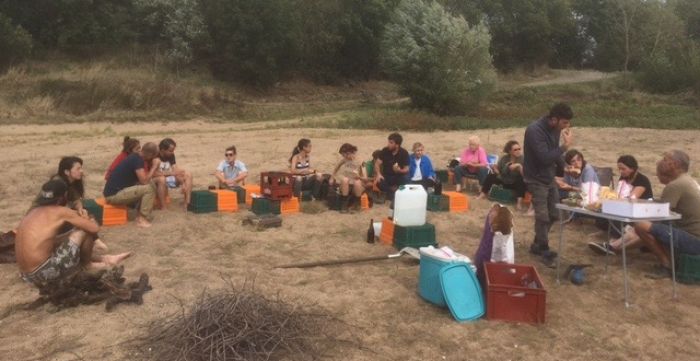
harvest report
03.01.2023
2023 Harvest Report from Philippe Chevarin
<p>The 2023 <glossary term="Vintage" title="1109">vintage</glossary> was generous. </p>
<p>By the end of Spring the vines had produced a large amount of bunches. But with our experiences in the last few <glossary term="Vintage" title="1109">vintages</glossary> <span class="zalup"><span>(<glossary term="Frost" title="1135">frost</glossary><span>,</span></span></span> <span class="zalup"><span><glossary term="Mildew" title="1137">mildew</glossary><span>,</span></span></span> <span class="zalup"><span><glossary term="Drought" title="1167">drought</glossary><span>,</span></span></span> birds and any combination of four), we remained only modestly euphoric. <glossary term="Flowering" title="1179">Flowering</glossary> came all at once throughout the entire <glossary term="Estate" title="427">estate</glossary> and took less than a week.</p>
<p>Despite fairly strong <glossary term="Mildew" title="1137">mildew</glossary> pressure that we were able to contain up until late July, the summer was perfect for vines. We got rains that were not only sufficient but that came at exactly the right times. Temperatures were also more clement than in past years, less extreme and stressing to the vines. And while tourists complained it was a "rotten" summer, the lack of a constant, pounding sun also did the vines a lot of good. The 2023's feel like the <glossary term="Loire Valley" title="602">Loire</glossary> of years past, a profile we've increasingly forgotten can exist.</p>
<p>Yet the harvest still began in late August, just like last year for our pied de cuve. It's by and large time to accept the the vines' vegetative cycle is noticeably shorter. Our first week of picking was during an intense heat-wave, forcing us to work only in the early morning. The team suffered quite a bit from the heat but was extremely courageous. And since there were so many grapes on the vines, we needed a whole other week to pick everything! </p>
<p>The <glossary term="Fermentation" title="441">fermentations</glossary> went well, no bacterial pressure like last year. Our only real issue was where to put all the wine, a unique problem for me that I'd love to have every year. I'm happy with the results, with some wines drinking in a very light style to enjoy within the year and others with great <glossary term="Concentration" title="324">concentration</glossary> and <glossary term="Acidity" title="71">acidity</glossary> that will age well. I'll <glossary term="Bottling" title="185">bottle</glossary> everything in March 2024.</p>
<p>Blanc Détour is a <glossary term="Direct Press" title="392">direct-press</glossary> of <glossary term="Melon de Bougogne" title="646">Melon de Bourgogne</glossary> from purchased grapes.</p>
<p>Rosé Détour is a <glossary term="Direct Press" title="392">direct-press</glossary> of <glossary term="Cabernet Franc" title="216">Cabernet Franc</glossary> from purchased grapes.</p>
<p>Le Souffle is 100% <span class="zalup"><span><glossary term="Melon de Bougogne" title="646">Melon de Bourgogne</glossary><span>,</span></span></span> a <glossary term="Blend" title="168">blend</glossary> of <glossary term="Direct Press" title="392">direct-presses</glossary> and short <span class="zalup"><span><glossary term="Maceration" title="610">macerations</glossary><span>,</span></span></span> from one to three days.</p>
<p>La Décrue is a <glossary term="Direct Press" title="392">direct-press</glossary> of <glossary term="Gamay" title="478">Gamay</glossary> <span class="zalup"><span><glossary term="Teinturier" title="1017">Teinturier</glossary><span>,</span></span></span> <span class="zalup"><span><glossary term="Gamay" title="478">Gamay Noir à Jus Blanc</glossary><span>,</span></span></span> <glossary term="Grolleau" title="513">Grolleau Noir</glossary> and <glossary term="Melon de Bougogne" title="646">Melon de Bourgogne</glossary> and released as a <span class="zalup"><span><glossary term="Nouveau/Primeur" title="725">primeur</glossary><span>.</span></span></span></p>
<p>Les Sentinelles is 100% <span class="zalup"><span><glossary term="Gamay" title="478">Gamay</glossary><span>,</span></span></span> 100% <glossary term="De-stemming" title="378">de-stemmed</glossary> and <glossary term="Maceration" title="610">macerated</glossary> for 12 days.</p>
<p>Le Magny is 100% <glossary term="Gamay" title="478">Gamay</glossary> Magny (an ancient local variety from a single <glossary term="Parcel" title="760">parcel</glossary>), 100% <glossary term="De-stemming" title="378">de-stemmed</glossary> and <glossary term="Maceration" title="610">macerated</glossary> for 14 days. </p>
<p><img src="https://louisdressner.com/uploads/images/article//987/0a/7e/0a7e9628f6290fc729893122191eb047.jpg" /></p>
<p><img src="https://louisdressner.com/uploads/images/article//987/40/75/4075e22c4cd03f11c5c6663904e31d08.jpg" /><img src="https://louisdressner.com/uploads/images/article//987/6f/fa/6ffaac1bfef538958dc1963e4a6b58a0.jpg" /><img src="https://louisdressner.com/uploads/images/article//987/18/1d/181d07b264f1f9c66d59910977094f1a.jpg" /></p>
Article
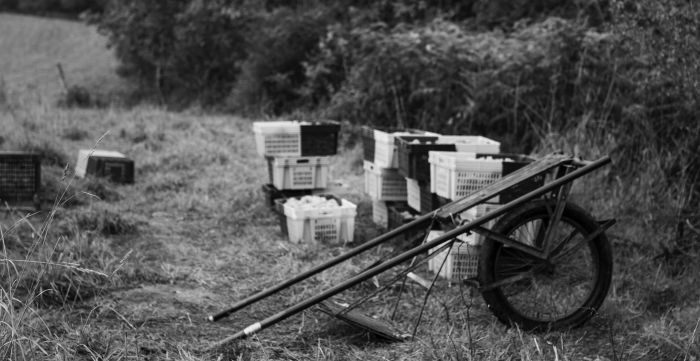
harvest report
02.01.2022
2022 Harvest Report from Philippe Chevarin
<p>After a mild and dry winter, the wine began <glossary term="Budding" title="1166">budding</glossary> "early", though at this point feels like the normal time for this occur. And with this, the inevitable: a small Spring <glossary term="Frost" title="1135">frost</glossary> damaged La Justice, the most <span class="zalup"><span><glossary term="Frost" title="1135">frost</glossary><span>-</span></span></span>prone <glossary term="Parcel" title="760">parcel</glossary> of <span class="zalup"><span><glossary term="Melon de Bougogne" title="646">Melon de Bourgogne</glossary><span>.</span></span></span> A few weeks later, now that the the <glossary term="Cluster/Bunch" title="1138">bunches</glossary> had formed and were quantitative, a <glossary term="Hail" title="1136">hail</glossary> storm hit mostly the <glossary term="Coteau" title="345">coteaux</glossary> on the south side of the <span class="zalup"><span><glossary term="Loire River" title="603">Loire</glossary><span>,</span></span></span> more or less sparing me save for damaging the wood and foliage in Grangers, my <glossary term="Old Vines" title="740">old vines</glossary> of <glossary term="Melon de Bougogne" title="646">Melon</glossary> planted in 1948. Finally, we had next to no rain from mid-June to mid-August, and even then it was only a few millimeters, not nearly the amount we needed. And don’t forget that we had three heatwaves at over 40°C, making the Loire-Atlantique the hottest region in France at certain points of the summer!</p>
<p>Hydric stress was intense: the vines stopped growing and the grapes remained small and thick-skinned. And despite all of this, thanks to the the extraordinary resilience of the vine plant, I was able bring in a medium <glossary term="Harvest" title="521">harvest</glossary> to the <span class="zalup"><span><glossary term="Cellar" title="254">cellar</glossary><span>.</span></span></span> All the while repeating to myself that, considering the calamities throughout the year, I was coming out lucky! We began <glossary term="Harvest" title="521">harvesting</glossary> on August 30th for the <glossary term="Aligoté" title="91">Aligotés</glossary> I use as a <span class="zalup"><span><glossary term="Pied de Cuve" title="792">pied de cuve</glossary><span>,</span></span></span> then a new <glossary term="Parcel" title="760">parcel</glossary> of <glossary term="Melon de Bougogne" title="646">Melon</glossary> on September 2nd. Then it was a continuous rhythm ending in the <glossary term="Cabernet Franc" title="216">Cabernet Franc</glossary> and <glossary term="Cabernet Sauvignon" title="217">Cabernet Sauvignon</glossary> on the 24th.</p>
<p>The <glossary term="Vinification" title="1104">vinifications</glossary> were very challenging because of a high presence of bacteria linked to very high <glossary term="PH" title="783">PH</glossary> levels. It required extreme vigilance to accompany the <glossary term="Must" title="700">musts</glossary> into wine. 2022 is a <glossary term="Vintage" title="1109">vintage</glossary> that will have remained complicated until the very end! But the profile of the wines remains surprisingly balanced compared to other hot <glossary term="Vintage" title="1109">vintages</glossary> like 2018 or 2019, with nice <glossary term="Acidity" title="71">acidity</glossary> that counter-balance the high alcohol and <span class="zalup"><span><glossary term="Concentration" title="324">concentration</glossary><span>.</span></span></span></p>
<p>In the end I made six <glossary term="Cuvée" title="363">cuvées</glossary> that I plan to bottle on March 16th, 2023:</p>
<p><strong>Le Souffle:</strong> <glossary term="Melon de Bougogne" title="646">Melon de Bourgogne</glossary> with a large percentage <glossary term="Maceration" title="610">macerated</glossary> for three days.</p>
<p><strong>La Décrue:</strong> a <glossary term="Direct Press" title="392">direct press</glossary> of <glossary term="Gamay" title="478">Gamay</glossary> <span class="zalup"><span><glossary term="Teinturier" title="1017">Teinturier</glossary><span>.</span></span></span></p>
<p><strong>Les Sentinelles:</strong> a <glossary term="Blend" title="168">blend</glossary> of <glossary term="Gamay" title="478">Gamay</glossary> and <span class="zalup"><span><glossary term="Grolleau" title="513">Grolleau</glossary><span>,</span></span></span> some<font color="#7b143e"><b> </b></font><span class="zalup"><span><glossary term="Carbonic Maceration" title="236">carbonically macerated</glossary><span>,</span></span></span> some <span class="zalup"><span> <glossary term="De-stemming" title="378">destemmed</glossary><span>.</span></span></span></p>
<p><strong>Le Magny:</strong> 100% <glossary term="Gamay" title="478">Gamay</glossary> Magny, <span class="zalup"><span><glossary term="De-stemming" title="378">destemmed</glossary><span>.</span></span></span></p>
<p><strong>Le Detour Blanc:</strong> a <glossary term="Blend" title="168">blend</glossary> of négoce <glossary term="Chardonnay" title="271">Chardonnay</glossary> and my <span class="zalup"><span><glossary term="Melon de Bougogne" title="646">Melons</glossary><span>.</span></span></span></p>
<p><strong>Le Détour Rosé:</strong> a <glossary term="Blend" title="168">blend</glossary> of <glossary term="Négociant" title="729">négoce</glossary> <glossary term="Cabernet Franc" title="216">Cabernet Franc</glossary> with my own <glossary term="Cabernet Franc" title="216">Cabernet Franc</glossary> and <span class="zalup"><span><glossary term="Cabernet Sauvignon" title="217">Cabernet Sauvignon</glossary><span>.</span></span></span></p>
<p><img src="https://louisdressner.com/uploads/images/article//970/3d/d0/3dd09e301ee92141c25f659356599f53.jpg" /><img src="https://louisdressner.com/uploads/images/article//970/f5/15/f51597f66273f5b9df3339c17310c81c.jpg" /><img src="https://louisdressner.com/uploads/images/article//970/b7/ad/b7ad0755b98dea8775e8523aff5fd407.jpg" /><img src="https://louisdressner.com/uploads/images/article//970/d0/9e/d09e398e80a97407fee33d4914f649a1.jpg" /></p>
Article
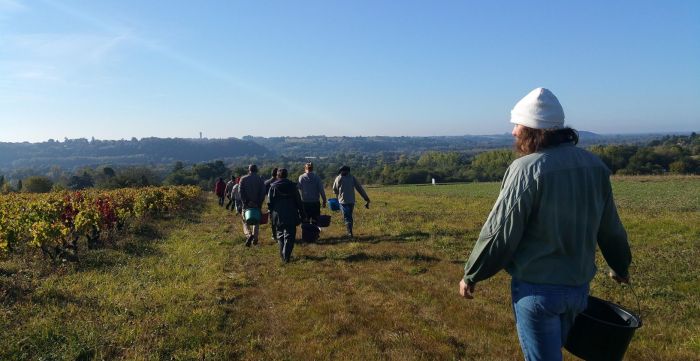
harvest report
16.12.2021
2021 Harvest Report from Philippe Chevarin
<p>2021 will have been the most difficult <glossary term="Vintage" title="1109">vintage</glossary> to manage since I started in 2015. Everything had started well with abundant but certainly precocious <glossary term="Budding" title="1166">bud-break</glossary> (this is happens every year now because the winters are too mild). I told myself I'd be able to produce as much as 2020 and for the first time in my career have two great <glossary term="Vintage" title="1109">vintages</glossary> in a row. Of course what followed was an unprecedentedly long and intense <glossary term="Frost" title="1135">frost</glossary> snap that dashed my hopes. We had a first wave on April 6th, 7th and 8th then a second on the 12th, 13th, 14th, 15th and 16th with temperatures getting as low as -4°C each morning. </p>
<p>In the end we'd lost 75% of the crop and morale was back to being at an all time low. And what followed was no walk in the park either: constant rain until mid-August resulted in tremendous <glossary term="-Select term-" title="">mildew</glossary> pressure. Fortunately, the collective I belong to, Pinards et Jus d'Ancenis, agreed quickly that we would work together to find grapes from other regions to <span class="zalup"><span><glossary term="Vinification" title="1104">vinify</glossary><span>.</span></span></span> In the end I was able to make some <glossary term="Sémillon" title="1003">Semillon</glossary> and <glossary term="Muscadelle" title="696">Muscadelle</glossary> from <glossary term="Bergerac" title="1459">Bergerac</glossary> and some <glossary term="Cabernet Franc" title="216">Cabernet Franc</glossary> from <span class="zalup"><span> <glossary term="Anjou" title="105">Anjou</glossary><span>.</span></span></span> Finding grapes was a very intense, human and shared aventure with Jacques Février, Benoît Landron et Marc Pesnot.</p>
<p>We went to <glossary term="Bergerac" title="1459">Bergerac</glossary> to <glossary term="Harvest" title="521">harvest</glossary> on September 15th, then waited a long time for <glossary term="Maturation" title="639">maturities</glossary> to develop in Oudon, everything was very late because of the constant rain. We picked the first <glossary term="Melon de Bougogne" title="646">Melons</glossary> on September 29th (September 1st in 2020!) and kept at it until October 16th with the <span class="zalup"><span><glossary term="Cabernet Franc" title="216">Cabernets</glossary><span>.</span></span></span> </p>
<p>In the end I made as much wine as 2020 but with the majority coming from outside my region. There will be five <span class="zalup"><span><glossary term="Cuvée" title="363">cuvées</glossary><span>:</span></span></span></p>
<p>– Le Souffle, a white from <glossary term="Melon de Bougogne" title="646">Melon de Bourgogne</glossary><br />
– Coup d'Pouce, a <glossary term="Rosé/Rosato" title="871">rosé</glossary> from <glossary term="Cabernet Franc" title="216">Cabernet Franc</glossary> and <glossary term="Cabernet Sauvignon" title="217">Cabernet Sauvignon</glossary><br />
– Les Sentinelles, a red of <glossary term="Gamay" title="478">Gamay</glossary>/<glossary term="Grolleau" title="513">Grolleau</glossary><br />
– Le Détour blanc, a <glossary term="Négociant" title="729">négoce</glossary> <glossary term="Sémillon" title="1003">Sémillon</glossary>/<glossary term="Muscadelle" title="696">Muscadelle</glossary><br />
– Le Détour rouge, <glossary term="Négociant" title="729">négoce</glossary> <glossary term="Cabernet Franc" title="216">Cabernet Franc</glossary></p>
<p>The <glossary term="Fermentation" title="441">fermentations</glossary> went well and the wines are now waiting patiently to be <glossary term="Bottling" title="185">bottled</glossary> in the spring. The <glossary term="Vintage" title="1109">vintage</glossary> is presenting itself to be very "<glossary term="Loire Valley" title="602">Loire</glossary>" with nice <glossary term="Acidity" title="71">acidities</glossary> and finesse. Perfect wines to drink with abandon!</p>
<p><img src="https://louisdressner.com/uploads/images/article//923/ac/af/acafe24984ad525b3fb3201c1f58ee47.jpg" /><img src="https://louisdressner.com/uploads/images/article//923/35/68/356812f4f242933697cf0b1ab256a723.jpg" /><img src="https://louisdressner.com/uploads/images/article//923/2e/0f/2e0f4385a18efd30f2f93734d35d873d.jpg" /><img src="https://louisdressner.com/uploads/images/article//923/c4/aa/c4aaa57d0d819818c0015d424da8ccdb.jpg" /></p>
Article
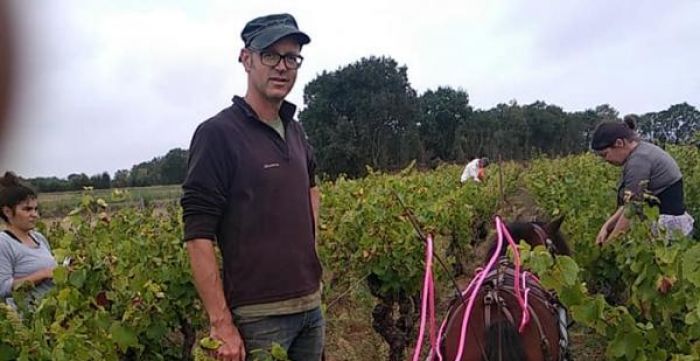
harvest report
13.09.2018
2018 Phillipe Chevarin Harvest Report
<p><img src="http://louisdressner.com/uploads/images/article/2019_Sep_18//7f/e5/7fe58e1de7767cef59bfb1f9ec502d40.jpg" /></p>
<p>2018 is another year where we narrowly avoided disaster. On May 1st, there was a drastic drop in temperature at night, resulting in some frozen buds but no real damage. On May 26th, we suffered a <glossary title="1136">hail</glossary> storm that touched about half of our land. The damage was mostly on the leaves and shoots, but again we were relatively spared. It mostly caused stress for the vine and the <span class="zalup"><span><glossary title="1089">vigneron</glossary><span>.</span></span></span><br />
<br />
The rest of the season went well despite a very strong <glossary title="1137">mildew</glossary> pressure and lack of water. The vines have compensated for the last two <glossary title="1109">vintages</glossary> of minuscule crops; grapes were beautiful and plentiful, almost too plentiful in certain sectors.<br />
<br />
We began harvesting on August 31st with a <glossary title="760">parcel</glossary> of <glossary title="646">Melon</glossary> destined for a <glossary title="792">pied de cuve</glossary> that would help kickstart the <glossary title="441">fermentations</glossary> of future juices. <glossary title="521">Harvest</glossary> itself took place under the hot sun. The <glossary title="1129">yields</glossary> are superior to what I'd estimated, it was almost a challenge to get everything into the <span class="zalup"><span><glossary title="1140">vats</glossary><span>!</span></span></span> It's a first for me since starting in 2015, and I have to say I'm thrilled!<br />
<br />
We finished on October 6th with the<strong> <glossary title="217">Cabernet Sauvignon</glossary></strong> under a dramatic downpour! The <glossary title="441">fermentations</glossary> have gone smoothly, with the <glossary title="622">malos</glossary> happening quickly, usually before the <glossary title="87">alcoholic fermentation</glossary> has finished. Fortunately this was without a spike in <span class="zalup"><span><glossary title="1116">volatile acidity</glossary><span>.</span></span></span><br />
<br />
In the end I am really happy with the <span class="zalup"><span><glossary title="646">Melon</glossary><span>:</span></span></span> I was able to <glossary title="1104">vinify</glossary> individual <glossary title="760">parcels</glossary> for the first time and I will wait for winter to decide the <span class="zalup"><span><glossary title="168">blends</glossary><span>.</span></span></span> The <span class="zalup"><span><glossary title="871">rosé</glossary><span>,</span></span></span> from a <glossary title="478">Gamay</glossary> <glossary title="1017">Teinturier</glossary> base, will be quite colored. Three <glossary title="1140">vats</glossary> of <glossary title="478">Gamay</glossary> were <span class="zalup"><span><glossary title="1104">vinified</glossary><span>,</span></span></span> all quite different. Again, I will wait for winter to decide on <span class="zalup"><span><glossary title="168">blends</glossary><span>.</span></span></span><br />
<br />
I will likely <glossary title="185">bottle</glossary> everything in March.</p>
Article
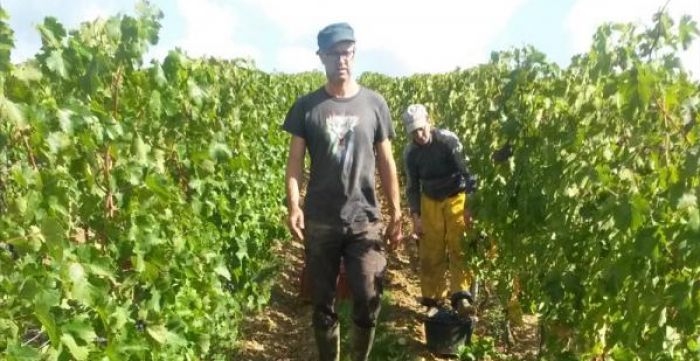
harvest report
11.10.2017
2017 Phillipe Chevarin Harvest Report
<p>In 2017, the vines decided to grow very precociously. Following the catastrophic 2016 (<glossary title="1135">frost</glossary> and <glossary title="1137">mildew</glossary>), the buds were rather promising in terms of quantity. And then, a late April <glossary title="1135">frost</glossary> decimated 80% of my future crop.<br />
<br />
I am lucky to be part of a collective of likeminded <glossary title="1089">vignerons</glossary> called <em>Pinards et Jus d'Ancenis</em>. We are all close to each other geographically and philosophically. For the last five years, we boat down the <glossary title="603">Loire</glossary> with our wines from Oudon to <glossary title="707">Nantes</glossary> on in an effort to make a larger public discover our <span class="zalup"><span><glossary title="1026">terroirs</glossary><span>.</span></span></span><br />
<br />
This association also permits us to exchange greatly on our practices, to share work equipment and to not feel alone when faced with difficult situations. Through this solidarity, we were able to collectively able to get grapes from a few <glossary title="760">parcels</glossary> that were supposed to be torn out. We started working them in May and maintained them up to <span class="zalup"><span><glossary title="521">harvest</glossary><span>.</span></span></span><br />
<br />
The <glossary title="521">harvest</glossary> snuck up on us, and arrived very early. I started on August 31st, 15 days in advance. My neighbor Jacques Février and I shared a <glossary title="521">harvest</glossary> team, and we began with the <span class="zalup"><span><glossary title="646">Melon de Bourgogne</glossary><span>.</span></span></span> It was very complicated to organize everything, as we had to juggle between the ripe grapes on the <glossary title="760">parcels</glossary> that hadn't frozen, the less ripe grapes on <glossary title="1135">frosted</glossary> vines (sometimes within the same <span class="zalup"><span><glossary title="760">parcel</glossary><span>!</span></span></span>) the solidarity <glossary title="760">parcels</glossary> we were <glossary title="521">harvesting</glossary> collectively with other <glossary title="1089">vignerons</glossary> and grapes that were offered to us at the last minute we ended up buying.<br />
<br />
It was an extremely difficult three weeks both mentally and physically, which in the end resulted in a little more grapes than last year. But the quality was very heterogeneous, and thus harder to <span class="zalup"><span><glossary title="1104">vinify</glossary><span>.</span></span></span> I'm rather satisfied with the final result, even if some small <glossary title="1140">vats</glossary> have proven challenging. I continue to learn in this third, atypical <span class="zalup"><span><glossary title="1109">vintage</glossary><span>.</span></span></span></p>
<p><img src="http://louisdressner.com/uploads/images/article/2019_Sep_18//f9/b0/f9b051a11e77b16e800c42028545ce48.jpg" /></p>
<p><img src="http://louisdressner.com/uploads/images/article/2019_Sep_18//66/ff/66ff44c834482ee1bfd3968ea1c516c0.jpg" /></p>
<p><img src="http://louisdressner.com/uploads/images/article/2019_Sep_18//08/33/08333e6e6fd63fb949ba99c4e99a8ace.jpg" /></p>
<p><img src="http://louisdressner.com/uploads/images/article/2019_Sep_18//d8/8a/d88a8e9de71b41d2a7dc5ef95dc1c416.jpg" /></p>
<p><img src="http://louisdressner.com/uploads/images/article/2019_Sep_18//c2/69/c269aa1d547f2db724d3e3ce8443b1e4.jpg" /></p>
<p><img src="http://louisdressner.com/uploads/images/article/2019_Sep_18//29/45/29453349777cc231efaef5aeac1367dc.jpg" /></p>
<p><img src="http://louisdressner.com/uploads/images/article/2019_Sep_18//d0/3c/d03c6cbffd25445cbe406161f9481fcb.jpg" /></p>
Article

















